The Mesolithic Era is not a sexy topic that will win friends and influence people at parties. But, it is something foragers should think about. If you are a survivalist it is mandatory knowledge.
Mesolithic literally means middle stone, or the Middle Stone Age. When exactly that was is a bit of a debate. Some places got metallurgy before others so it is a fluid definition. Let’s put it at 8,000 to 10,000 years ago for northern Europe and perhaps North America as well. Metallurgy might have migrated around the north polar regions after that. More specifically, what we’re interested in is the time before man was using metal. What does that have to do with foraging?
Well, everybody foraged back then. It was how one lived. In fact, most of your time was spent foraging, going from food source to food source. Throw in hunting and a few fights and you have your 9 to 5 Mesolithic day, though dawn to dusk might be more accurate. What can possibly be instructive about foragers 8,000 years ago? One consideration is how they cooked food without pots and pans. That brings us to fire.
A camp fire is more than burning wood. Which wood, the size of the wood, and how the fire is made allows for great sophistication in cooking, particularly without pots or pans. Even in my youth with a wood cook stove in the basement, the kind of fire and wood was important.
If we were roasting potatoes, we wanted steady hot coals that put out a consistent heat for an hour or two. That usually meant a hard wood of medium size reduced to coals. If it was biscuits for breakfast it was a fire made of small soft wood, like pine. That produced a very hot but short fire, perfect for making biscuits and browning them in a few minutes. Baking bread required large pieces of hard wood.
There is not only the fires to consider but the coals and ashes, the ground and local material such as stones and leaves to wrap food in or make mats out of. For example, the “traditional” New England Clam Bake is a method of cooking devised before there were pots and pans.
When I was a kid, we would go down to the Maine shore at low tide late on a summer afternoon. We’d wade out to an island about a half a mile from shore, getting quite muddy in the process. Once on the island we would dig a pit, line it with rocks, and build a big fire. Then we’d go looking for food…. crabs under seaweed, mussels, sometimes fish caught in tidal pools, clams in the mud. When the fire had burnt down, we toss all the stuff in the hot pit: Fish and crabs on top, cover it all with seaweed, then cover the seaweed with dirt. We’d then go play and or build a small camp fire nearby because we always spent the night. In a couple of hours we’d shovel off the dirt and seaweed and have a feast. In the morning we’d warm up what we hadn’t eaten and play until the tide was low enough to wade back to the mainland. No pots, no pans, no forks or knives. Fresh nutritious food.
Every time I collect a wild edible I ask myself how could the foragers of the mesolithic prepare it? Roots would be roasted, sometime in the fire itself, sometime beside the fire. Some roots were buried in the ground before the fire was started and not uncovered until the foragers were ready to move on days later. This was particularly so with roots in the Americas that had calcium oxalates in them that only break down with long dry heat. Some nuts were roasted in sand under a short hot fire. Depending on the fire and the food cooking could be in, around, over or under a fire.
Some greens, nettles for example, can be wilted by the fire and made edible in a matter of seconds. Others have to be steamed. Some small roots can be buried in the ashes and covered with dirt. Why dirt? Dirt locks out oxygen and keeps the roots from charing. If you buried a wrapped fish the sand will also keep it from charing. Baking was also possible if you had clay. The food was wrapped in grass or another suitable leaf, and all of it encased in clay. Then the clay “oven” was set next to the fire and tended, turned now and then to cook the food. Eggs were wrapped in clay or had a small hole cracked on top and propped up in the ashes.
Learning to cook like a cave man has several advantages. The first one is you know how to cook no matter where you are as long as you can make fire. The second is you don’t have to carry a lot of pots and pans to eat well. Third, such cooking forces you to think about the plant and ways to use it. And primary cooking is usually more nutritious. Fresh food, freshly cooked and into you not long after harvested is healthy. It is also leaving out a lot of the non-food stuff in processed food these days. Cooking fish and game is similar to plant materials. They can be roasted, steamed or baked. It depends on the food and the materials on hand.
If I am traveling light, I take one pot/pan for all possible cooking needs and a few spices. I forage along the way for meals. If I am driving to a site and camping, then I dig out my cast iron ware and set up a wilderness kitchen — ya gotta play now and then. The idea behind both methods of cooking is not to survive but thriving, not subsistence but living well while in the wilds.
Regardless of what wild food you cook or how you cook it, knowing how to prepare it without pots and pans brings useable knowledge and independence to your outdoor experience. I’ll cover more techniques in the future.

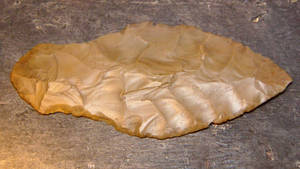
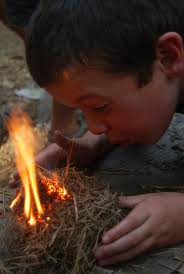
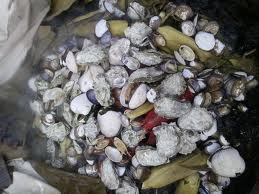
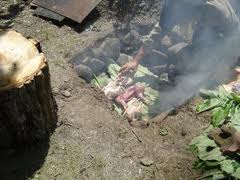
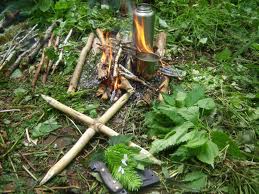
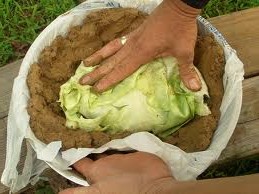

I love this post. It’s awesome. I once brought some potatoes to cook during a camp-out, but forgot the pot. They weren’t cooking quickly enough on a stone at the edge of the fire, so I tossed them right into the coals. After letting them cool, I peeled away the charred outer edges to reveal perfectly cooked potato flesh.
It made me wonder how the very early humans would have typically cooked their tubers, especially if they were thinner tubers that would have been mostly burnt if done in my way. It’s neat to think about the ways they would have devised to make it work.
Can you link your other posts that talk about this sort of thing?
In what county was your “flint knife”found? It very closely resembles the point that killed Oetzi the Ice Man.
You are very correct, of course, eating Palaeo does not mean eating raw. Humanity has had fire for a long, long time.
Many thanks for your reply.
Seminole County, Florida,